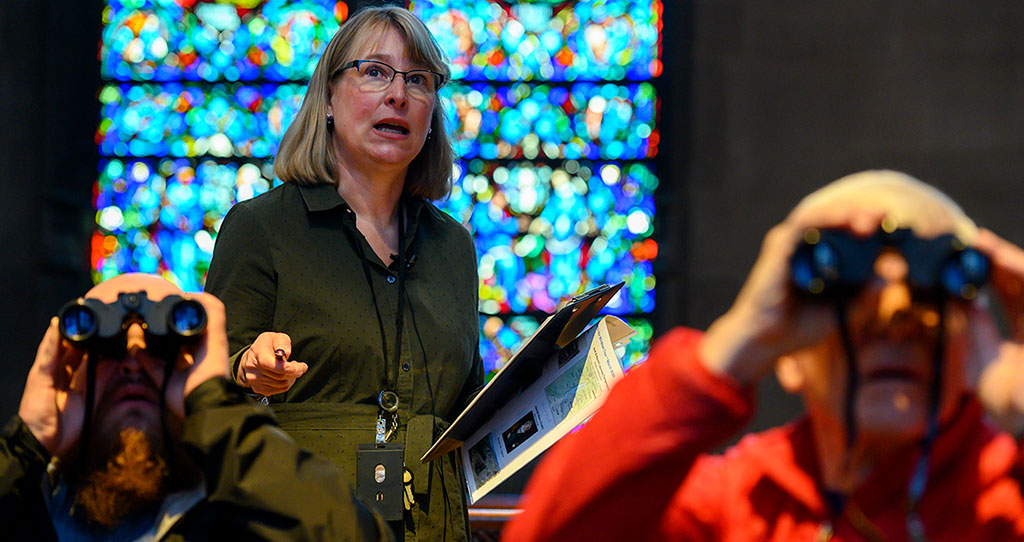When Pittsburgh-born condiment magnate H. J. Heinz died in 1919, he left money in his will specifically for the University of Pittsburgh to erect a building on its grounds to honor his mother, Anna Margaretta Heinz.
As a result, Heinz Memorial Chapel was built during the 1930s, an elegant neo-Gothic structure with 23 stained-glass windows. Four of them in the center of the chapel, called the north and south transept windows, were delivered by rail car from Charles Connick’s Boston studio. At 73 feet, they are among the tallest stained-glass windows in the world.
Thirty-six men and 36 women are featured in the transept windows.
“I thought that was remarkable,” said Karen Sebolt, the chapel’s docent and event coordinator who conducts tours. “To feature women at that time was unusual.”
To honor Women’s History Month, every Tuesday, the chapel is offering free noon-hour tours of the chapel windows, during which Sebolt will specifically point out and discuss some of the women featured. Other events, such as concerts highlighting female performers and organ works by women will also celebrate women throughout March.
Among the women in the windows is Elizabeth Fry, a Quaker from England who visited Newgate Prison in London and was horrified at what she saw—overcrowding, rampant disease, women housed with men.
“After the visit, Elizabeth returned with clothing and food for the inmates,” Sebolt explained during a recent tour. “She started classes for the inmates and advocated for women and men to be housed separately.” Fry is sometimes called “the angel of prisons.”
John Nelson, a history buff visiting from North Carolina, appreciated hearing about Fry at the month’s first tour.
“My mom is a pastor who has done prison work. Hearing about that woman who went to all the jails—that’s a familiar feeling. I’m going to tell my mom about her if she doesn’t already know about it.”
While this month’s tours are pointing out some of the more obscure women, more familiar faces are also in the glass—Joan of Arc, Florence Nightingale, English novelist Emily Bronte, American Red Cross founder Clara Barton, and other activists and poets.
High at the top of a south transept window is Ruth, a Biblical character who symbolizes loyalty and devotion. Pitt English Department Chair and Professor Gayle Rogers, who studies global modernisms, said that Ruth has long been recognized as a model for the woman émigré.
“This likely appealed to Pittsburgh’s history of immigration, which the Cathedral and Nationality Rooms obviously incorporate as well,” he said.
Political theorist Madame de Staël is also featured. “She is large forgotten now but in the early 20th century, she was seen as a major figure in women’s intellectual history and widely read by intellectuals across Europe and the U.S. well into the 1930s,” said Rogers.
Pitt Assistant Professor of History Alaina Roberts says, of all the women in the windows, Pocahontas is her favorite.
“She was an important intermediary between her people, the Powhatan, and British colonists in Virginia,” she said. “Pittsburgh has a rich and complicated colonial history on European-Native American relations, so it is fitting that a Native woman who did so much is depicted at one of our city’s landmarks.”
Sebolt has another theory as to why there are just as many women as men featured in the transept windows.
“The committee formed to work on the design of the chapel included Pitt’s first Dean of Women Thyrsa Amos,” she said. “She probably sat there in the meetings and said ‘Let’s do this!’”
This news release was originally published at http://pittwire.pitt.edu/news/women-windows.





